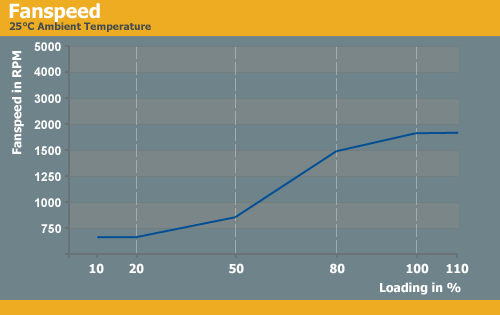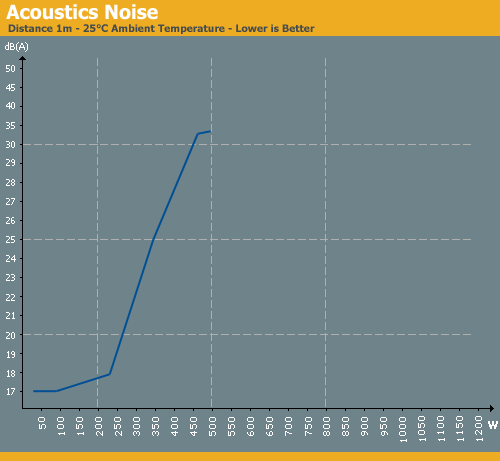Thermaltake TR2 QFan Series
by Christoph Katzer on November 19, 2008 3:00 AM EST- Posted in
- Cases/Cooling/PSUs
Temperatures, Fan Speed, and Acoustics

Both primary heatsinks hold stable at up to 40°C throughout testing, only surpassing that threshold when we overload the power supply. It's also nice to see that temperatures immediately decrease once the fan starts spinning faster. Of course we need to keep in mind that the heatsinks and fan don't need to deal with nearly as much heat, since these are only 300W to 450W PSUs. That's one of the benefits of using a smaller power supply.
We have previously commented that we didn't like the standard CWT heatsink design, with their "umbrella" fins blocking airflow and failing to dissipate heat as well as we would like. This time, due to less produced heat and a desire to cut costs, CWT used smaller heatsinks and the different temperature results are immediately visible. The only complaint we have is with the third heatsink; it should be larger, since even at room temperature it reaches up to 80°C.

The fan spins at a very tame 650RPM for the first couple loading stages. Once we reach 50% load, fan speed quickly begins to ramp up and is at 1500RPM with 80% load. The good news is that the heatsinks immediately get cooler, but the drawback is increased noise output. With a slightly better heatsink design and improved fan speed control, it should be possible to keep temperatures and noise levels down.

The acoustic noise develops fast with increasing fan speed. Going from 650RPM to 1500RPM brings a nice fat 10dB(A) increase in noise, which is not very good. The maximum noise output of 33dB(A) is unfortunately very loud. We strongly recommend that users interested in keeping noise levels down try to stay under 50% of the rated PSU output.










36 Comments
View All Comments
Slomo4shO - Wednesday, November 19, 2008 - link
Would it be possible to include CORSAIR CMPSU-400CX, PC Power & Cooling Silencer PPCS420X, OCZ ModXStream Pro OCZ400MXSP, and OCZ ModXStream Pro OCZ500MXSP in your upcoming write-up?Christoph Katzer - Wednesday, November 19, 2008 - link
Yep, have them already here.Havor - Thursday, November 20, 2008 - link
Hi Christoph nice reviewBut if you really be cool if you would put all the tested PSU's in a database.
ware you can select a power rating (like say 400~450W) and see on a graf how all the PSUs performs in that W-rating
http://img03.picoodle.com/img/img03/3/11/20/f_PSUg...">http://img03.picoodle.com/img/img03/3/11/20/f_PSUg...
A other thing that would be nice would be if you would give all PSU a grade from 0~100 ware 100 would be a PSU perfect PSU <15db/100% eff./DC output perfect flat/temp <30c/PFC = 1/build quality perfect
And then turn it in a graf. and cross it whit personal most important part for HTPC builders that would be db, for people building a server it would be high % efficacy
Mr Perfect - Wednesday, November 19, 2008 - link
It would be interesting to know what Seasonic is up to these days. Their old S12 line was quite impressive in it's day.Oh, and anything that has more then just one 6pin PEG connector. Someone with a reasonably powered system might still want to hook in a 4870 or GTX260, seeing how games are generally GPU limited today.
Netcraazzy - Wednesday, November 19, 2008 - link
I'd love to see a head-to-head comparison between these PSUs and similar units from Antec, OCZ, Seasonic, Sparkle and others. I'm especially interested in the 400w-500w range.Amart - Wednesday, November 19, 2008 - link
Opinion seconded, well done with the review. I especially appreciate the attention to quality and ripple graphs, as these are of prime concern when recommending a PSU.